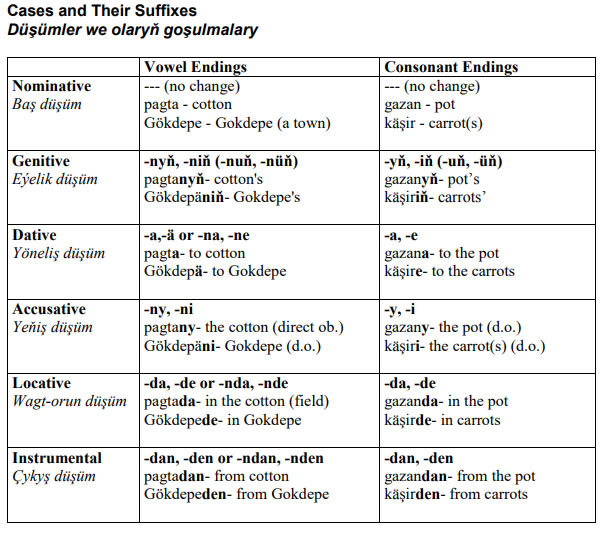Difference between revisions of "Language/Turkmen/Grammar/The-Case-system"
Jump to navigation
Jump to search
| Line 1: | Line 1: | ||
Like Russian or German, Turkic languages have a system of grammatical cases. Cases change words depending on their grammatical context. | Like Russian or German, Turkic languages have a system of grammatical cases. Cases change words depending on their grammatical context. | ||
Turkmen has six cases, and these cases are used for all nouns, not just personal prounouns. The six Turkmen cases are: | Turkmen has six cases, and these cases are used for all nouns, not just personal prounouns. | ||
The six Turkmen cases are: | |||
#the nominative, used for the subject of the sentence; | #the nominative, used for the subject of the sentence; | ||
#the genitive, similar to English possessives; | #the genitive, similar to English possessives; | ||
| Line 7: | Line 10: | ||
#the locative, which shows locality; | #the locative, which shows locality; | ||
#and the instrumental, which is used to show origin. | #and the instrumental, which is used to show origin. | ||
While six cases might seem a bit overwhelming at first, it should be noted that the case suffixes often simply replace our English prepositions such as | While six cases might seem a bit overwhelming at first, it should be noted that the case suffixes often simply replace our English prepositions such as | ||
| Line 15: | Line 20: | ||
*on, | *on, | ||
*to. | *to. | ||
Also, the rules for their use are remarkably simple and inflexible, unlike those of the Russian cases. | Also, the rules for their use are remarkably simple and inflexible, unlike those of the Russian cases. | ||
[[File:Case turkmen.jpg]] | [[File:Case turkmen.jpg]] | ||
== Sources == | == Sources == | ||
https://photos.state.gov/libraries/turkmenistan/868986/pdf/TurkmenLanguageLearningGuide_001.pdf | https://photos.state.gov/libraries/turkmenistan/868986/pdf/TurkmenLanguageLearningGuide_001.pdf | ||
Revision as of 23:26, 8 December 2020
Like Russian or German, Turkic languages have a system of grammatical cases. Cases change words depending on their grammatical context. Turkmen has six cases, and these cases are used for all nouns, not just personal prounouns.
The six Turkmen cases are:
- the nominative, used for the subject of the sentence;
- the genitive, similar to English possessives;
- the dative, used to show directed action;
- the accusative, which is similar to the English direct object
- the locative, which shows locality;
- and the instrumental, which is used to show origin.
While six cases might seem a bit overwhelming at first, it should be noted that the case suffixes often simply replace our English prepositions such as
- from,
- at,
- with,
- in,
- on,
- to.
Also, the rules for their use are remarkably simple and inflexible, unlike those of the Russian cases.
Sources
https://photos.state.gov/libraries/turkmenistan/868986/pdf/TurkmenLanguageLearningGuide_001.pdf
